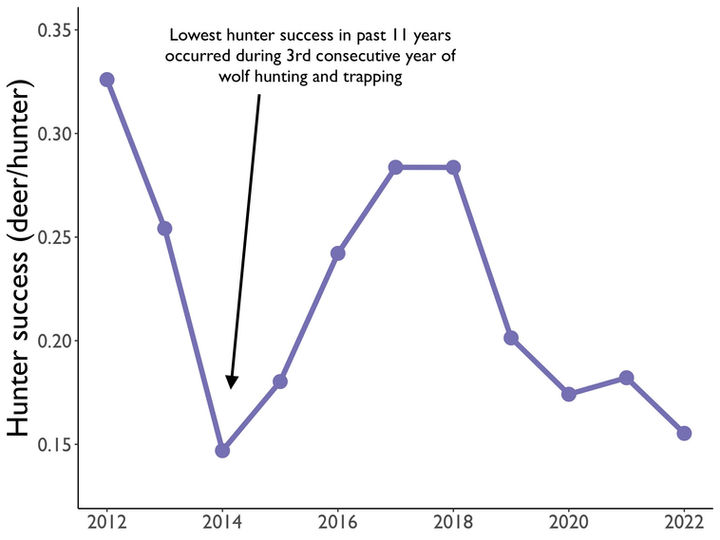Wolves, deer, and deer hunting in northeastern Minnesota: the data

There is much debate regarding the role wolves have on deer populations and deer hunting in particular. Many have stated that wolves are "decimating" the deer population in Minnesota and that we need to kill wolves to resolve this issue. We examined publicly-available information collected by the Minnesota Department of Natural Resources from 2012 to 2022 regarding deer hunting (number of deer hunters, deer harvested, etc.) in northeastern Minnesota, including the area we study wolves, the Greater Voyageurs Ecosystem.
We compared deer hunter success with 1) data from Minnesota's 3 most recent wolf hunting/trapping seasons (2012-2014) to see whether killing wolves had any noticeable impact on deer hunter success, and 2) data on wolf and deer populations based on data we have collected in the Greater Voyageurs Ecosystem since 2015 to assess whether deer hunter success was lower when there were more wolves.
We have included graphs of all of these data below so everyone can see what the data tells us about the relationship between wolves, deer, and deer hunting.

The big takeaways:
1). The number of deer hunters in northeastern Minnesota has declined substantially through time and with it, the number of deer harvested. Thus, using the number of deer harvested as a metric to assess the impact of wolves on deer and deer hunting is a terrible idea. A better metric to use is deer hunter success because that accounts for changing number of hunters through time.
2). Deer hunter success was highest before wolf hunting/trapping seasons in 2012-2014 in Minnesota and hunter success decreased dramatically during 2012 to 2014 despite killing up to 16% of the wolf population annually.
3.) Deer hunter success and wolf population size were both positively correlated with the size of the deer population. In other words, hunters kill more deer and there are more wolves when there are more deer.
4.) Deer hunter success is positively correlated with wolf population size. When there are more wolves around, hunters are more successful. Again, this is because hunter success and wolf populations both increase as deer populations get larger.
5.) Wolves are not the primary reason for changes in deer populations or deer hunter success. Indeed, one of the most important factors driving deer population change is winter severity. What do 2014, 2022, and 2023—all years when deer hunter success and deer populations have been at their lowest—have in common? Long snowy winters.
The data: see them for yourself

The relationship between the number of deer hunters and deer harvested in northeastern Minnesota during 2012-2022 based on Minnesota Department of Natural Resources data. The data indicates that the number of deer harvested is largely driven by the number of hunters in the woods. Despite this clear pattern, many use the reduced deer harvest as evidence of the impact of wolves on deer and deer hunting. However, it is clear that relying on number of deer harvested each year is a poor way to assess deer hunter success and a better metric is to examine the number of deer harvested per hunter because that accounts for changing number of hunters through time. Note: the different colors correspond to data from different Deer Permit Areas in northeastern Minnesota.

The number of hunters (blue line) and the number of deer harvested (black line) in each Deer Permit Area in northeastern Minnesota. The number of deer hunters in northeastern Minnesota has declined substantially through time and with it the number of deer harvested.

Deer hunter success (deer harvested per hunter) in northeastern Minnesota over the past 11 years per Minnesota Department of Natural Resource data. The lowest deer hunter success rates were in 2014 after 2 years of wolf hunting/trapping and in 2015, after 3 years of wolf hunting/trapping, deer hunter success was similar to average hunter success during 2020-2022. The highest deer hunter success over the past 11 years were in 2012, just before 3 years of wolf hunting/trapping began. I.e., the 2012-2013 wolf hunting/trapping season began in Fall 2012 and would not have affected the Fall 2012 deer harvest.

The relationship between wolf population size in the Greater Voyageurs Ecosystem and hunter success (deer harvested per hunter) in the 4 Deer Permit Areas (108, 118, 119, 177) in and adjacent to the Greater Voyageurs Ecosystem, Minnesota. Deer hunter success is positively correlated with wolf population size. In other words, hunters are more successful when there are more wolves around. Why? Because wolf population size and hunter success are both driven by the size of the deer population. Note: The shaded area represents confidence intervals around the trendline. Wolf population size was measured as wolf density (wolves per 1000 square kilometers).

How deer hunter success (top) and wolf populations (bottom) track deer populations in the Greater Voyageurs Ecosystem through time. Both deer hunter success (deer killed per hunter) and wolf populations are positively correlated with deer populations. Note: wolf and deer populations estimates for the GVE were measured in density (wolves per 1000 square kilometers and deer per square kilometer, respectively) and were only available starting in 2015.
